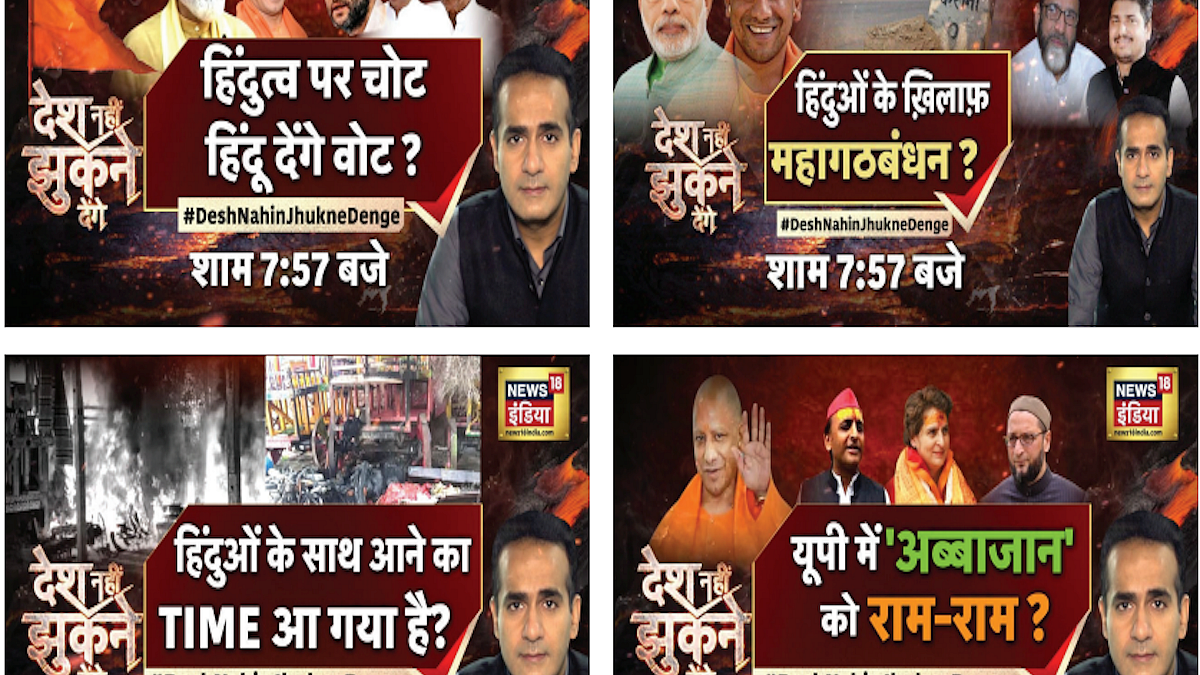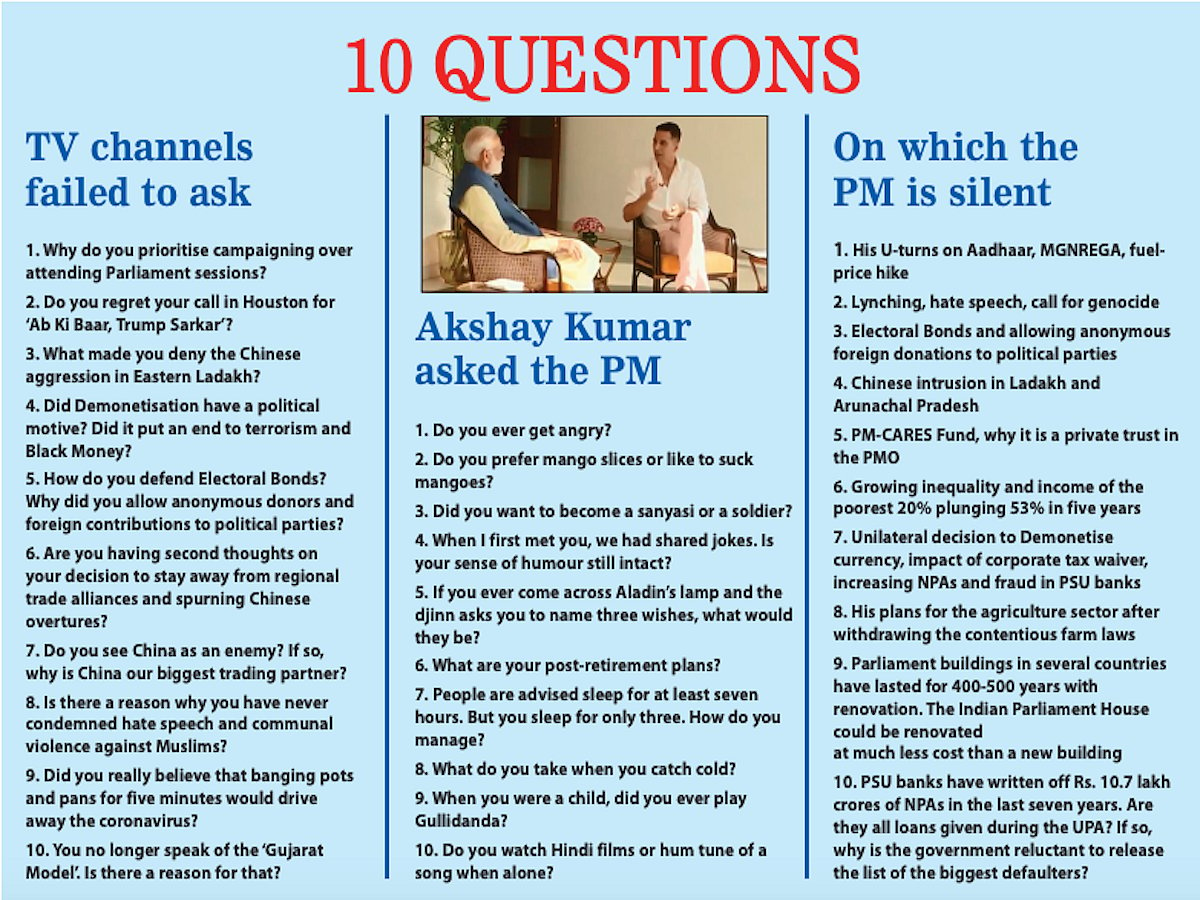Made for each other: Modi and the ‘Godi’ media
Perceived popularity of Prime Minister and Government is promoted, protected, amplified by pliable media. Is it due to carrots and stick or is it because media owners want to have cake and eat it too?

Violent protests over railway recruitment exams are a reminder of how Indian news media completely ignores the single biggest story of our time: unemployment. When was the last time there was a 9 pm TV debate on unemployment? A magazine cover?
The question posed on social media by a journalist and columnist this week elicited one honourable exception: Ravish Kumar on NDTV India. He has consistently raised the issue and amplified the angst of unemployed youth. But what about the rest of the media?
In a tweet on January 26, Mohammed Zubair, co-founder of fact checking website AltNews responded by listing the number of tweets by news anchors on the violent protests in Uttar Pradesh and Bihar.
He did not mention Arnab Goswami but it is unlikely that the figure would have been very different in his case too. All the star TV anchors listed are active on social media and have been liberal in sharing their opinion on political developments and defections. But “there is never any reference on unemployment, inflation, failed economy, agriculture crisis etc. while TV discussionsare held on silly issues of communal nature, leaders joining BJP and which way different castes will be voting”, pointed out a TV news viewer.
There is a pattern which has emerged over the last few years. TV channels are prone to raise and discuss issues which show the BJP Government and the Prime Minister in positive light. While the Prime Minister receives saturation coverage, often live, minute-by-minute coverage of him offering puja, press conferences of opposition leaders are often ignored. Anything that remotely questions the government, is critical of government policies or reflects poorly on the Prime Minister is sidelined.
There is no conclusive answer on whether this pattern is by design or by default. An explanation offered is that most TV channels are owned by Mukesh Ambani, the richest Indian whose support for the BJP and the Prime Minister is well known. Another explanation is that the government has emerged as one of the biggest advertisers, much bigger than private businesses, and the media cannot afford to antagonize the piper, choosing to dance to the piper’s tunes.

The Union Government has arguably spent more money on publicity in the last eight years than any government in the past. Advertising industry has grown at 13% per annum as a result even when production stalled and the economy tanked. Conflicting figures have been provided to RTI queries and to Parliament. But a conservative estimate puts the amount spent on advertising by the Union Government at around Rs.10,000 crore and an equal amount by PSUs and BJP-ruled states in the last eight years or so. Almost all of them were utilised to build the image of the Prime Minister.
This is not an insignificant amount and explains why the BJP and a large section of the mainstream media are “mad for each other”. Media outlets have never been money spinning ventures and now with the economy doing badly, they are even more reluctant than ever to miss out on government support.
That also explains the readiness to carry the government’s narrative. The incestuous relationship is now such that notings, official communication, WA chats and even evidence allegedly collected by investigating agencies are shared with friendly TV channels on prime time. While the Government has shown its willingness to go the extra mile to oblige ‘friendly’ media, it has not been averse to baring its fangs and show its displeasure by sending an Income Tax notice or hold out the threat of a ‘raid’. Such raids on both NDTV and Newsclick are still fresh in memory.
Stopping government’s patronage and threats of boycotting media events, which are both money spinners and networking opportunity for business, lobbyists and industry, have also been effective in making the media fall in line.
There is clearly some truth in the belief that the media has played a major role in building up the larger-than-life image of Prime Minister Modi. Although he has not addressed a single unscripted press conference in almost eight years as PM, has not spoken a word on the failing economy and the failure of many of his pet schemes like Smart Cities, Make in India and Namami Gange, Hindi and English TV news channels have avoided discussing such issues.
Even as international media has increasingly questioned the PM’s authoritarian style of functioning, the country’s human rights record, the slide of the economy and the Modi Government’s chest thumping on various issues, Indian TV channels have been largely reverential. They have treated the PM with velvet gloves, letting him off even after he claimed that China had not intruded into India despite mounting evidence to the contrary, and even after 20 Indian soldiers were killed in Galwan valley.


Eyebrows were raised this month when Times Now got the UP chief minister to flag off the channel’s Chunav Rath, a bus with reporters, equipment and TV crew that would apparently be used for election coverage in the poll-bound state. But why invite the chief minister to flag off the bus? A wag quipped, “Till now it was Times Now which carried BJP and Yogi’s flag but now Yogi is carrying Times Now’s flag”.
Could the state government have sponsored the bus or the coverage in any way? Uttar Pradesh Government in any case has been the biggest spender on advertisements among the states and has sponsored big ticket events hosted by media outlets. While politically correct neutrality might be an overrated virtue, TV anchors of late have worn their political preferences on their sleeves. Editors and TV anchors could barely suppress their glee when a Congress leader from UP quit the party and joined BJP this week. In sharp contrast, when three ministers quit BJP to join Samajwadi Party in Uttar Pradesh earlier this month, the ‘defection’ was described as opportunism and condemned as immoral.
Nor did it come as a surprise when the official Twitter handle of Network 18 asserted that the Samajwadi Party-RLD alliance had ‘silently’ (sic) fielded 10 Muslims in phase 2 of the election in UP. The unhappy choice of the word ‘silently’ possibly reflected only poor command over the language. But it managed to convey the unfortunate insinuation that Muslim candidates were fielded surreptitiously and that somehow this was not proper.
Would it have made any difference to the political landscape if the media had been less partisan? Possibly yes. Narendra Modi’s popularity and myths around him owe much to the media. The reluctance to question the Government and the PM on omissions and commissions, in sharp contrast to the hysterical attacks on the UPA and Dr Manmohan Singh, has contributed to build an aura around him while pushing the Government’s narrative on farmers’ protest, Kashmir, Pulwama terror attack, Chinese intrusion and other tricky issues.
The BJP was heading for a ‘historic defeat’ in UP, claimed Sanjay Sharma emphatically during a video discussion on Satya Hindi, one of the several YouTube channels that have emerged as alternative media. Sharma, Lucknow based editor of an eveninger who has his own YouTube channel, scoffed at opinion polls and surveys which show BJP returning to power in the largest state.
His co-panelists concurred. BJP believes people have a short memory and that is proving to be their undoing, said one. Another panelist pointed out that all the surveys have so far shown a steep decline in the number of seats that BJP can win this time in UP and correspondingly a sharp increase in the number of seats going to the Samaj.
The consensus of the panel was that there was strong anti-incumbency against Yogi Adityanath on the ground and the Samajwadi Party would benefit from the negative votes cast by voters. It is either ‘Yogi Bachao’ or ‘Yogi Bhagao’, the panel held and a large section within the state BJP, they asserted, wanted the Yogi to be shown the door.wadi Party. “What I don’t understand is how these surveys decide where the decline or the rise of support stop and at how many seats,” he quipped sardonically.
This was however strikingly at variance with the ‘Mood of the Nation’ surveys, opinion polls and debates being aired by ‘national’ TV channels for past several weeks. Media houses, which fell over each other in hailing Yogi Adityanath as the best chief minister and UP as the ‘Number One’ state, gave the impression that both Yogi and BJP were well on their way to win the crucial election.
Indian mainstream media and particularly TV channels have been markedly partisan. They have aggressively questioned the opposition, particularly Congress and Rahul Gandhi, accusing them of being less than competent, less than honest, less than patriotic and for being no match to Narendra Modi and the BJP. The TV channels have denied equal time to the opposition on their shows, often inviting one opposition representative on panels with three or more BJP supporters and spokespersons.
India Today’s magazine cover displayed the familiar photograph of the Prime Minister. The cover line read: ‘In Modi We Trust’. People trust Modi was the unambiguous message, the finding of its ‘Mood of the Nation’ survey. It was unsurprising and scarcely raised an eyebrow. But two unflattering comments from buyers at a news stall captured the growing contempt for the media.
“Media hai toh Modi hai,” murmured one while another looked at the India Today cover and declared, “In this Modi we do not trust”.
Views are personal
(This article was first published in National Herald on Sunday.)
Follow us on: Facebook, Twitter, Google News, Instagram
Join our official telegram channel (@nationalherald) and stay updated with the latest headlines
